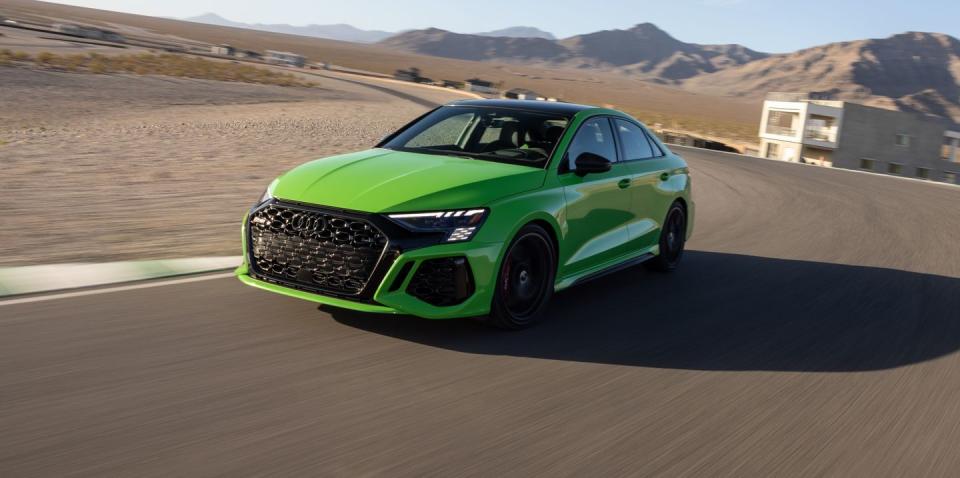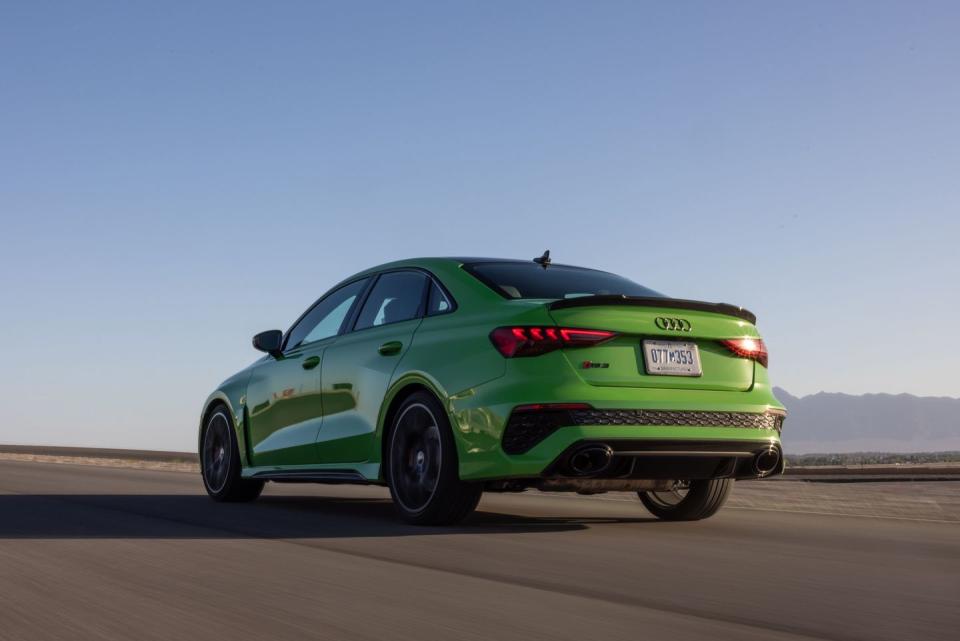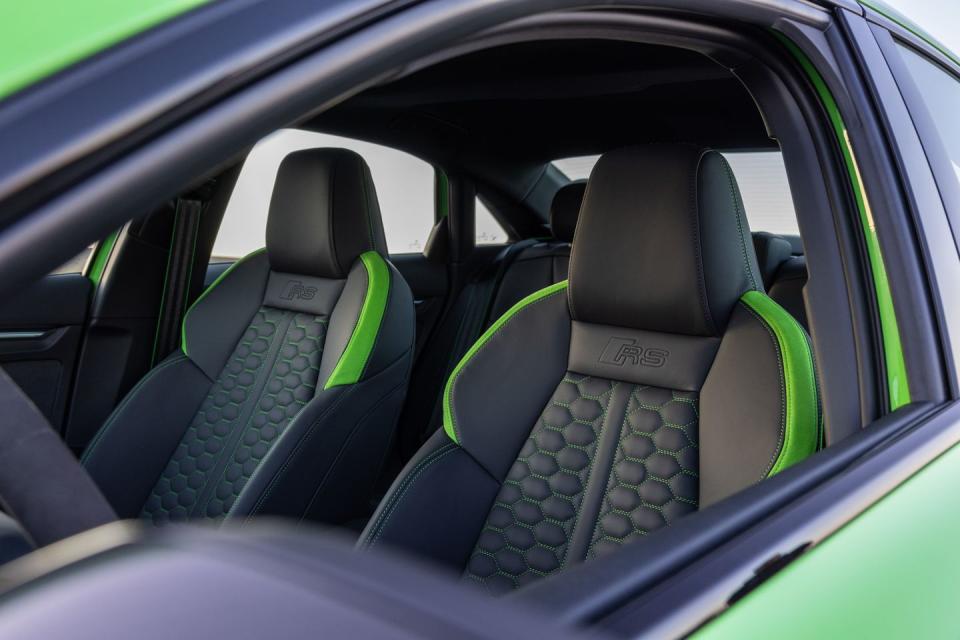2022 Audi RS 3 Returns with 401 HP and Quattro Control

New Audi RS 3 packs 401 hp into a compact five-seat sedan with a seven-speed dual-clutch S tronic® transmission promising "lightning-quick shifts."
Set to the right drive mode you can even drift it!
Price is an entirely reasonable (for this much performance) $59,995.
We should be glad there are sedans at all in these the last few model years of four-door three-box “cars.” And we should likewise be happy there’s even something powered by gasoline as the waning days of internal combustion creep upon us and drive over our collective clutch foot. Soon the world will be fully taken over by bland crossover utility vehicles with very efficient battery-electric drivetrains. Maybe the world will be better (?), maybe it’ll be a dystopian nightmare. Who’s to say? Lord knows we have to do something about pollution. Yet even now at this late date, almost every competent carmaker on the planet is not only still offering sedans, but mighty, powerful, sporty sedans that are not just fun to drive but quite often downright thrilling.
Someday you will tell your grandkids about it.
Until then, consider these: the 505-hp Alfa Romeo Giulia Quadrifoglio, 503-hp BMW M3 and coming M2, the 472-hp twin-turbo V6-powered Cadillac CT4 Blackwing, the Mercedes AMG C43 putting out 385 hp, and now this, the new Audi RS 3, racking up 401 hp, AWD and a paint-blistering top speed of 180 mph if you spring for the ceramic brakes necessary to bring it back to a standstill from such delirious velocity.
The RS line, as you may know, is the top tier of Audi performance, a big step up from the S Line and two steps up from the base A3. There have been RS 3s before, starting in 2011 and again in 2015 with European sales only, both powered by the storied Audi five-cylinder engine. In 2017 U.S. buyers could get ahold of an RS 3 that offered 400 European horsepower, or 394 American ponies, from a 2.5-liter five. That car shared its drivetrain and its MQB platform with the TT RS.

Now comes this, the 401-SAE-horsepower RS 3 you see here, with a seven-horsepower and 15-lb-ft improvement in power and torque compared to its predecessor, good for 0.3-second drop in 0-60 time to 3.6 seconds and a top speed of 180 mph. It’s longer, taller, wider, and “more aggressive” than the previous RS 3. It even comes with the first true motorsport tire option for really holding on in those corners—Pirelli P Zero Trofeo R motorsport rubber. And with its “Torque Splitter” rear axle and myriad electronic controls, you can even make it drift. It has an inch and a half wider front track, one more degree of negative camber in front and a half degree more rear and the tires are almost a half inch wider all around.
So it’s no wonder the very first place they let us drive it was at a race track—the exciting new East Course at Spring Mountain Motorsports Ranch in fabulous Pahrump, the Nurburgring of southwestern Nevada. At the real Nurburgring the RS 3 set what Audi says is a lap record “for compact cars” of 7:40.748. That’s a more-than respectable time for any car, let alone one that carries five adults and their luggage.
On Pahrump’s new course, the RS 3 immediately felt familiar. In fact, with three fewer cylinders it felt like the old Audi RS4 V8 except smaller and even more responsive. The 401 hp felt more powerful than the original 1999-2001 RS4 V8 Avant and was, in fact, 26 hp more than that vaunted V—and only 13 fewer hp than the later B7-powered RS4 sedan of 2006-2008. With a curb weight of 3649 pounds, the new RS 3 is within a hundred or so pounds compared to all the old RS4 trims, yet smaller, lighter, and more nimble.
That power-to-weight ratio is put to best use with quattro AWD, with power going to all four wheels. The car I had also came with the Carbon Ceramic brakes which meant that, had the East Course’s front straight continued on farther than it did I could’ve easily hit that 180 mph top speed. As it was, later, out on empty two-lanes in the wide, flat desert, let’s just say without admitting anything for legal purposes, the car could easily—and way before you know it—hit at least 150 mph. Even the desert has limits.

Back on the track the RS 3 was one of those sport sedans so well thought out that after a while you find yourself throwing it into a corner however fast you want and keep steering and the car will gather itself together and power on out of there without you necessarily needing much talent at all. It was stable as all get-out. With Dynamic Chassis Control set up properly you can even drift like a FormulaD king.
The one part of the drivetrain Audi seems to be most proud of, if measured only by mentions-per-square-paragraph in the press kit and in the presentations, was that Torque Splitter rear. That feature is a set of clutch packs on the rear half shafts that can lock, unlock or slip around to send torque to the rear wheel that needs it most. This isn’t all that new—heck, the Acura MDX had it ten years ago. But it’s used to far sportier effect on the RS 3.
So what does it all mean? Will electric cars be able to do all that and still make you smile? Yes, but not the same way. Instead of the Audi five-cylinder’s distinctive guttural roar you’ll have a series of whirrs and clicks and that electric motor sound the same as you get on a blender or an electric toothbrush. This car still offers the suck-squish-bang-blow of four-cycle, gasoline-fed internal combustion blasting power out to the universe and for now, for just a couple more years, that’s kinda cool.

 Yahoo Autos
Yahoo Autos 